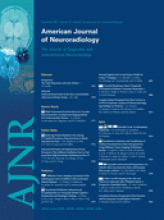Research ArticleNeurointervention
Risk Analysis of Unruptured Aneurysms Using Computational Fluid Dynamics Technology: Preliminary Results
Y. Qian, H. Takao, M. Umezu and Y. Murayama
American Journal of Neuroradiology November 2011, 32 (10) 1948-1955; DOI: https://doi.org/10.3174/ajnr.A2655
Y. Qian
H. Takao
M. Umezu

Submit a Response to This Article
Jump to comment:
No eLetters have been published for this article.
In this issue
Advertisement
Y. Qian, H. Takao, M. Umezu, Y. Murayama
Risk Analysis of Unruptured Aneurysms Using Computational Fluid Dynamics Technology: Preliminary Results
American Journal of Neuroradiology Nov 2011, 32 (10) 1948-1955; DOI: 10.3174/ajnr.A2655
Jump to section
Related Articles
- No related articles found.
Cited By...
- Cerebral aneurysm hemodynamics indicative of instability are associated with heterogeneous wall motion measured by amplified MRI
- A practical strategy for data assimilation of cerebral intra-aneurysmal flows using a variational method with boundary control of velocity
- Evaluation of aneurysm rupture risk based upon flowrate-independent hemodynamic parameters: a multi-center pilot study
- Evaluation of aneurysm rupture risk based upon flowrate-independent hemodynamic parameters: a multi-center pilot study
- Intracranial Aneurysm Wall Displacement Predicts Instability
- Identification of Small, Regularly Shaped Cerebral Aneurysms Prone to Rupture
- Hemodynamic Analysis of Postoperative Rupture of Unruptured Intracranial Aneurysms after Placement of Flow-Diverting Stents: A Matched Case-Control Study
- Quantification of hemodynamic irregularity using oscillatory velocity index in the associations with the rupture status of cerebral aneurysms
- Differences in Morphologic and Hemodynamic Characteristics for "PHASES-Based" Intracranial Aneurysm Locations
- Computational fluid dynamics of cerebral aneurysm coiling using high-resolution and high-energy synchrotron X-ray microtomography: comparison with the homogeneous porous medium approach
- Hemodynamics in growing and stable cerebral aneurysms
- Hemodynamic-morphological discriminant models for intracranial aneurysm rupture remain stable with increasing sample size
- Rupture Resemblance Score (RRS): toward risk stratification of unruptured intracranial aneurysms using hemodynamic-morphological discriminants
- The Computational Fluid Dynamics Rupture Challenge 2013--Phase I: Prediction of Rupture Status in Intracranial Aneurysms
- Morphologic and hemodynamic analysis of paraclinoid aneurysms: ruptured versus unruptured
- CFD: Computational Fluid Dynamics or Confounding Factor Dissemination? The Role of Hemodynamics in Intracranial Aneurysm Rupture Risk Assessment
- High WSS or Low WSS? Complex Interactions of Hemodynamics with Intracranial Aneurysm Initiation, Growth, and Rupture: Toward a Unifying Hypothesis
- Clinical Images - A Quarterly Column: Actively Rupturing Intracranial Aneurysm
- A retrospective analysis on the natural history of incidental small paraclinoid unruptured aneurysm
- Wall Shear Stress Distribution of Small Aneurysms Prone to Rupture: A Case-Control Study
- Effect of Bifurcation Angle Configuration and Ratio of Daughter Diameters on Hemodynamics of Bifurcation Aneurysms
- Hemodynamic Differences Between Unruptured and Ruptured Intracranial Aneurysms During Observation
This article has not yet been cited by articles in journals that are participating in Crossref Cited-by Linking.
More in this TOC Section
Similar Articles
Advertisement











